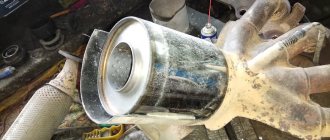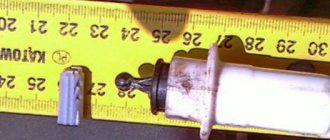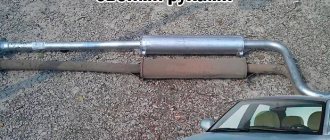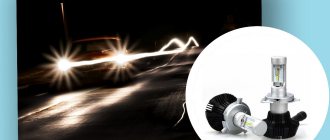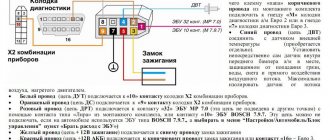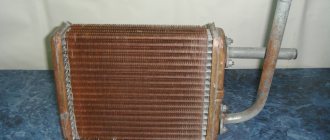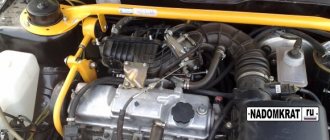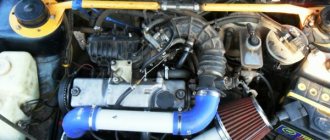An engine element such as spider 2114 is a type of exhaust manifold that provides the most optimal operating modes of the power plant.
Many motorists are thinking about replacing this part, because the original manifold on the VAZ 2114 is designed for operating modes in accordance with Euro-3 requirements, due to which the car loses more than 10 hp in power.
By simply replacing the base manifold with a spider, this situation can be easily corrected. We'll talk about how the spider itself works and how to install it below.
Spider on VAZ 2114
Types
There are two types of Spider currently sold on the market: 4-1 and 4-2-1. The difference between them comes down to the fact that in the first type, 4 pipes that are connected to the block head converge into one pipe, and it is already connected before the catalyst. The “spider” of the second type is different in that its 4 pipes first turn into 2 pipes, and those, in turn, into one, which is connected to the catalyst. In addition, the internal cavity of the “Spider” does not have the filling that is found in the standard manifold. This filling ensures compliance with the Euro-3 standard, and it also “presses” the VAZ 2114 engine.
Spider 4-2-1
The “Spider” type also influences the achievement of the desired effect. In order for pressure fluctuations in the exhaust system with type 4-1 to ensure good purging of the cylinders, the engine speed must be above 6500 rpm. That is, it is advisable to install such a “Spider” only on forced engines that provide high speeds.
Type 4-2-1 allows you to achieve the desired effect at low speeds, which makes it possible to use them on the VAZ-2114 even without modifications to the power plant.
It should be installed instead of a standard manifold, it will not particularly affect the operation of the engine; it will also require removing the catalyst and installing a resonator and a direct-flow exhaust system. In general, the entire exhaust system will have to be replaced. After such alterations, the VAZ-2114 will not meet any standards, but the car will become more playful. In addition, in the future there will be no need to replace a clogged catalyst, since it simply will not be in the system.
As for the disadvantages, the Spider provides a louder sound because the exhaust gases move through a direct-flow system. Many people like this sound, but when traveling long distances it can be very annoying. And the second drawback is that there can be no talk of any environmental friendliness.
But if you are tired of driving a VAZ-2114 with an engine that “drives” very calmly, then you should still install the “Spider”.
Types of collectors
The first type is a standard exhaust manifold. It is installed on most modern cars for more environmentally friendly operation and combines the manifold and catalyst. Its main job is to burn the remaining unburnt gasoline.
The disadvantage of such a manifold is poor exhaust gas permeability; the four pipes that come out of the engine are too thin. In addition, after leaving the engine, the exhaust gases rest against the catalyst honeycomb, and pressure forms in the manifold, as if the catalyst is strangling the engine. But since the catalyst has a certain service life and the price is quite high, car owners are trying to replace it with a spider (how can you check the catalyst?). The ideal exhaust system would be if the exhaust gases went straight out onto the street without any exhaust pipes or manifolds, but driving such a car would be neither possible nor legal.
Pros and cons of the spider 4-1
The second type of exhaust manifold is the 4-1 spider. The structure of such manifolds is similar to a factory catalyst, but the 4-1 spider has four pipes that come out of the engine with a larger diameter and the exhaust gas retention is less pronounced. As a rule, this type of collectors is cheaper.
Its structure is simpler and it is a simpler form. The design of such a collector involves the connection of four pipes into one thicker one and then a transition to the resonator. They are most often used on sports, high-revving engines, since the operating range of the 4-1 manifold is over six thousand revolutions.
Pros and cons of the 4-2-1 spider
And finally, the latest manifold design used in civilian, atmospheric tuning is the 4-2-1 spider. The purpose of such a spider is to lengthen the collector itself as much as possible and make sure that the exhaust gases leaving the engine touch and interfere with each other as little as possible.
The structure of such a manifold is made in such a way that the burnt gas-air mixture coming out of the first cylinder through pipes is connected to the fourth, and the second is connected to the third, and then these two pipes are connected into one.
What is needed to carry out the work?
You can carry out all the work yourself, having previously purchased everything you need. The alteration of the exhaust system can be partial, with the replacement of the catalyst with a resonator, but in this case, the “Spider” will not fully ensure its effectiveness, and a complete replacement of the exhaust system.
First of all, you need to buy the “Spider” itself for the VAZ-2114 car; it is better to take the 4-2-1 type. If the processing is complete, you will also need a resonator and a direct-flow muffler, and if it is incomplete, only a resonator. When replacing, the exhaust manifold gasket must be changed. You should only buy parts from reputable companies. Such a manufacturer is, for example, Stinger, but there are others.
Tools you will need:
- A set of keys;
- Welding machine (possibly);
- Grinding machine with cutting wheel (possibly);
- New exhaust system fasteners;
- Lambda probe with extended wiring;
- WD-40;
I installed the spider, do I need firmware?
Currently, there are a large number of manufacturers of sports spiders. They all claim that by installing a 4-1 spider or 4-2-1, the power of your four-cylinder engine will increase by up to 10%. This is confirmed by video clips and measurements on a dyno, but is it really so? Manufacturers don’t tell us a little, since replacing the standard manifold with a spider will disrupt the correct operation of the engine.
When a new car is produced, a standard program is installed in the engine control unit, which monitors exhaust gases and is set to a certain pressure in the exhaust manifold. When installing the spider, the pressure in the exhaust system changes and an engine error light appears on the dashboard. At the same time, the car begins to consume more gasoline and its power drops significantly. In order to avoid this, it is necessary to change the factory engine settings to the so-called euro two firmware, or even zero euro. Such firmware is more universal and can be easily installed at service stations where they do chip tuning. But absolutely identical motors simply do not exist, and in order to achieve maximum performance when installing a spider, you need to individually calibrate your engine.
Sequence of work
With all this at hand, you can get to work:
- We install the VAZ-2114 on the inspection hole and immobilize it. If the car is just from a trip, give the exhaust system time to cool. Remove the crankcase protection.
- We unscrew the bolts securing the exhaust manifold pants from the exhaust pipe of the catalyst and disconnect them. It is better to pre-treat the fastening bolts with WD-40.
- If the replacement is only partial, leave the catalyst and muffler in place for now. But with a complete replacement, we remove everything that comes from the collector’s pants from the VAZ-2114.
- Let's move on to the engine compartment. We unscrew the nuts securing the exhaust manifold to the block head, having previously treated them with WD-40.
- Carefully remove the standard manifold and the gasket located under it.
- Next, the Spider is installed. If the choice is made correctly, it will fall into place without problems. It is important not to forget to install a new gasket under it. If the old fastening nuts are heavily rusted, it is better to replace them with new ones, copper-plated or brass.
- Let's go under the car. In case of partial replacement, we try on the coincidence of the “Spider” with the exhaust pipe of the catalyst. Usually the “spider” is longer than the standard manifold, so the exhaust system will have to be shortened, which is why a grind is needed. machine (grinder) and welding machine. Then the catalyst is completely cut out. Along with the catalyst, it may be necessary to remove part of the pipe that goes behind it. And in its place a resonator is welded in, everything is first adjusted to the length.
- We connect the “Spider” to the receiving pipe of the resonator. This completes the partial replacement.
- For a complete replacement, we do the same as for a partial replacement, but with a new direct-flow system and resonator. That is, we hang a new exhaust system with a resonator on the car, take measurements, adjust it to length if necessary, connect and secure everything.
Spider 4 2 1 VAZ 2110 8 valves
This product was chosen by 20 customers
For an 8-valve engine with a nut for 1-2 oxygen sensors.
After installing the spider, you will need to change the standard program and an oxygen sensor extension. The spider is installed complete with a Stinger direct-flow resonator without welding; in the case of a standard resonator, welding will be required.
Diameters:
- primary pipes - 38 mm;
- secondary - 43 mm;
- output - 51 mm.
Material: steel 08 ps cold rolled.
Power gain: 9.5 hp
When ordering in the cart, in the order explanation line, indicate for how many sensors you need a Spider for 1 or 2!
Weight, kg: 4.55 Dimensions, cm: 76 x 37 x 32 Volume, m3: 0.08998
Spider and its varieties
The main difference between the spider and the original VAZ exhaust manifold is:
- absence of sharp corners in the path of gases;
- multi-level direct-flow system (4-2-1 type);
- lack of internal components (it is they, first of all, that “bring” the engine’s performance to the Euro-3 standard and at the same time reduce its power).
In terms of its structure, the spider 4 2 1 2114 is a complex system of tubes connected to each other. As you might guess, there are 4 pipes coming from the engine itself, which at some distance combine into 2, and then into 1 exhaust pipe. This combination of tubes during engine operation creates air pressure differences, which contribute to maximum cleaning and purging of the cylinders and, as a result, increasing the overall engine power.
It should be noted that after installing the spider, the “environmental friendliness” of the car will decrease, and there will be no compliance with the Euro-3 standard. In all other respects, replacing this part will only benefit the car.
In addition to spiders of type 4 2 1, the action of which has already been described, you can also find spiders of type 4 1 in stores. The difference between them is that in the latter version, 4 tubes extending from the engine immediately turn into 1, bypassing the intermediate stage of 2 tubes.
Such spiders are intended exclusively for boosted engines and provide an increase in power compared to a standard manifold only at speeds of 6500 rpm or more. That is why the spider 4 2 1 on the VAZ 2114 is a better option than the spider type 4 1.
It should be noted that the entire modernization process will not be limited to just installing the spider. In addition to this, you will also need to install a direct-flow exhaust system, a resonator and remove the catalyst.
Thus, if you decide to replace the manifold, you will, in fact, have to replace the entire exhaust system. True, you can limit yourself to just replacing the catalyst with a resonator, but in this case the overall increase in power will be noticeably less (about 5 hp instead of 12-15 hp with a complete replacement of the exhaust system).
What is the problem with release anyway?
There are only two problems:
- It's noise. That's why the exhaust system is often called a muffler to dampen loud sounds.
- This is ecology. Not all gases burn in the combustion chamber, and to put it in “simple language” they need to be “burned or decomposed” into more or less safe components, this is done by the catalyst.
If there were no muffler, the engine power would be approximately 10% more by default (depending on the valve and camshaft settings). BUT it would be impossible to drive such a car, firstly, you yourself would become deaf from the crackling sound that escapes from the engine (and you would be fined for disturbing the peace of citizens, this is now punishable by law), and secondly, the environmental component would be worse zero, because there is no catalyst (and we already have a polluted world that requires global cleaning) - it is not possible to pass MOT with such an indicator, and even now traffic police officers can easily check the exhaust.
In general, the gas muffling system CANNOT be removed, but it can be improved, which is exactly what tuners do.
Some features
There are several nuances that should be taken into account when modifying the exhaust system of a VAZ-2114. The installed tuning manifold is wider in size, so it will touch the rubber pipe leading to the stove. To prevent this from leading to coolant leakage in the future, this pipe should be replaced with a new, longer one, and taken away from the manifold.
The lambda probe will also have to be replaced, since the hole for its mounting in the tuning manifold is lower than in the standard one, which is why this sensor with extended wiring is needed.
Also, the “Spider” is more voluminous at the bottom, so installing underbody protection is no longer possible.
The final stage of all this work is reflashing the electronic control unit, which will allow the new exhaust system to be “perceived” as standard. Also, flashing will allow you to “unleash” the full potential of the power plant after processing. It is better to perform flashing from knowledgeable specialists at a service station.
This is all the work related to the processing of the exhaust system of the VAZ-2114 car.
Installing a spider on a VAZ 2114: subtleties of the process
An engine element such as spider 2114 is a type of exhaust manifold that provides the most optimal operating modes of the power plant.
Many motorists are thinking about replacing this part, because the original manifold on the VAZ 2114 is designed for operating modes in accordance with Euro-3 requirements, due to which the car loses more than 10 hp in power.
By simply replacing the base manifold with a spider, this situation can be easily corrected. We'll talk about how the spider itself works and how to install it below.
What is the problem with release anyway?
There are only two problems:
- It's noise. That's why the exhaust system is often called a muffler to dampen loud sounds.
- This is ecology. Not all gases burn in the combustion chamber, and to put it in “simple language” they need to be “burned or decomposed” into more or less safe components, this is done by the catalyst.
If there were no muffler, the engine power would be approximately 10% more by default (depending on the valve and camshaft settings). BUT it would be impossible to drive such a car, firstly, you yourself would become deaf from the crackling sound that escapes from the engine (and you would be fined for disturbing the peace of citizens, this is now punishable by law), and secondly, the environmental component would be worse zero, because there is no catalyst (and we already have a polluted world that requires global cleaning) - it is not possible to pass MOT with such an indicator, and even now traffic police officers can easily check the exhaust.
In general, the gas muffling system CANNOT be removed, but it can be improved, which is exactly what tuners do.
How to make a replacement
The entire replacement of the VAZ 2114 spider takes place in several stages:
- Place the car on an overpass or pit, put the handbrake on and secure the wheels with stops (shoes).
- If the car has been running recently, let it cool down.
- Remove the crankcase protection.
- Unscrew the bolts securing the exhaust manifold pants to the catalyst inlet (to make unscrewing easier, they should be treated with WD-40 lubricant before starting work).
- If the replacement is partial, then leave the catalyst and muffler in place; if it is complete, then remove it.
- Unscrew the nuts securing the manifold to the cylinder head.
- Dismantle the “original” manifold and the gasket located under it.
- Install the spider instead of the standard manifold (if the spider matches the model, then it will definitely fit into its place). Before installation, you should place a new gasket under it.
- If the old fasteners are severely corroded, then new ones should be installed instead, preferably coated with copper or brass.
- If a partial replacement is performed, then you need to check the alignment of the spider pipe with the catalyst inlet. As a rule, the exhaust pipe of the spider is longer, so you will have to cut off and dismantle not only the catalyst, but also part of the exhaust pipe, instead of which a resonator should be welded.
- Connect the spider's output pipe to the resonator.
- If a complete replacement occurs, then the same operations are performed as in the previous paragraphs, but instead of the entire “original” exhaust system, a direct-flow exhaust system is installed.
After installing the spider, you will also have to replace the lambda probe (with a new one, with an extended wire). The completion of the entire modernization process will be the flashing of the ECU, which should be performed at a car service center. It will help register the new system in the computer as “standard”, and will also show the increase in power obtained as a result of the upgrade.
